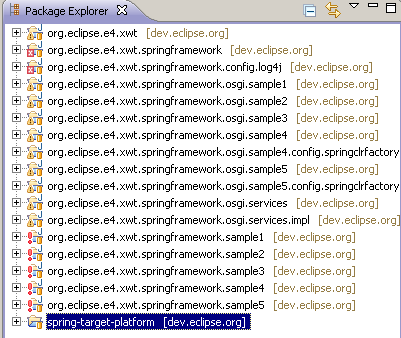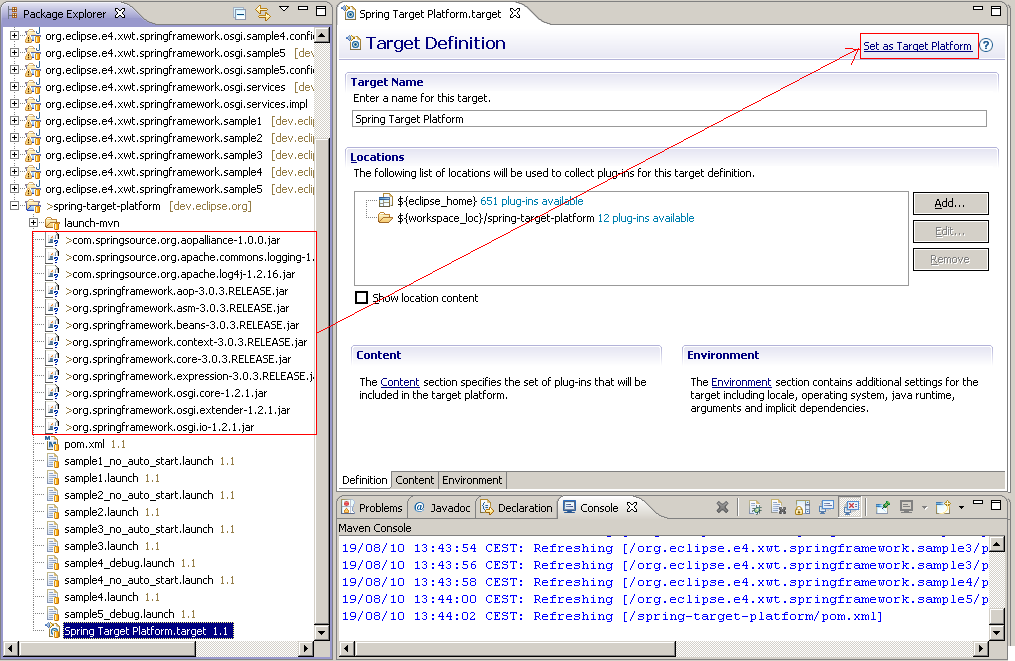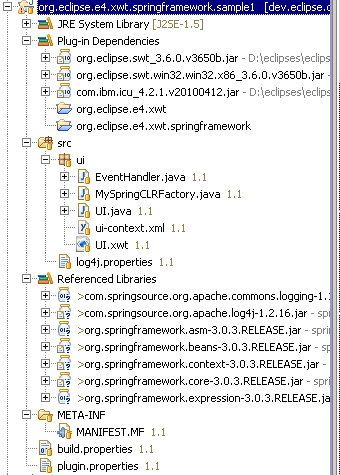Notice: This Wiki is now read only and edits are no longer possible. Please see: https://gitlab.eclipse.org/eclipsefdn/helpdesk/-/wikis/Wiki-shutdown-plan for the plan.
Using Spring with XWT
Contents
Introduction
Work is underway to integrate XWT with Spring and Spring Dynamic Module to declare the CLR classes used into XWT file with XML Spring file.
See (for the moment) Bug 320405. Attached to this bug are zips containing bundles
- org.eclipse.e4.xwt.springframework: bundle of XWT Spring support.
- org.eclipse.e4.xwt.springframework.tests : Tests (Main/JUnit) of XWT Spring support.
Samples with NO OSGi context :
- org.eclipse.e4.xwt.springframework.sample : simple sample to declare CLR as Spring bean.
- org.eclipse.e4.xwt.springframework.sample2 : simple sample to declare CLR as Spring bean which use Spring DI to use a service.
Samples with OSGi context :
- org.eclipse.e4.xwt.springframework.osgi.sample : simple sample to declare CLR as Spring bean.
- org.eclipse.e4.xwt.springframework.osgi.sample2 : simple sample to declare CLR as Spring bean which use Spring DI + Spring DM to use a service.
- org.eclipse.e4.xwt.springframework.osgi.services : bundle which provides HelloService.
CLR Class
Before explaining Spring support for XWT, it's interesting to understand how CLR Java class are managed with x:Class and x:ClassFactory.
CLR with x:Class
The Event Handling sample show you how XWT file can be linked to a Java CLR (Common Language Runtime) class to manage for instance event handler of the UI with Java code by using x:Class attribute :
<Shell xmlns="http://www.eclipse.org/xwt/presentation" xmlns:x="http://www.eclipse.org/xwt" x:Class="ui.EventHandler"> <Shell.layout> <GridLayout/> </Shell.layout> <Button text="Click Me!" SelectionEvent="clickButton"> </Button> </Shell>
The declaration x:Class="ui.EventHandler" means that the UI is linked to the Java class ui.EventHandler :
package ui; import org.eclipse.swt.widgets.Event; import org.eclipse.swt.widgets.Button; public class EventHandler { protected void clickButton(Event event) { Button button = (Button )event.widget; button.setText("Hello, world!"); } }
When the button gets selected, the method clickButton is invoked to change the Button text to "Hello, world!".
CLR with x:ClassFactory
You can do the same thing (link a CLR class with XWT) with CLR factory :
<Shell xmlns="http://www.eclipse.org/xwt/presentation" xmlns:x="http://www.eclipse.org/xwt" x:ClassFactory="ui.EventHandlerFactory"> <Shell.layout> <GridLayout/> </Shell.layout> <Button text="Click Me!" SelectionEvent="clickButton"> </Button> </Shell>
The declaration x:ClassFactory="ui.EventHandlerFactory" means that the UI is linked to the Java class which is provided by ui.EventHandlerFactory :
package ui; import org.eclipse.e4.xwt.ICLRFactory; public class EventHandlerFactory implements ICLRFactory { public Object createCLR(String args) { return new ui.EventHandler(); } }
This CLR factory implements org.eclipse.e4.xwt.ICLRFactory which returns an instance of ui.EventHandler which is the CLR class described below.
Overview - Spring support for XWT
The bundle org.eclipse.e4.xwt.springframework is the Spring support for XWT which implements org.eclipse.e4.xwt.ICLRFactory to declare CLR Class with bean Spring. It's possible to use this Spring support :
- into a "standard" Java context. Please see Using Spring with XWT section for more information.
- into an OSGi context. Please see Using Spring Dynamic Module (OSGi) with XWT section for more information.
Spring support for XWT will be explained with samples provided.
How test Spring support for XWT?
Before explaining Spring support for XWT, please follow the explained steps to try the samples of this Spring support. Samples are using Spring 3.0.3 ans Spring DM 1.2 but it was tested with Spring old version (2.5) and it works well.
Download Eclipse E4
XWT belong to Eclipse E4 project. To use XWT, download it.
Get last version of XWT from CVS
Today (09/09/2010) Eclipse E4 doesn't contains the ICLRFactory from XWT. Get org.eclipse.e4.xwt from the CVS :
- Host: dev.eclipse.org
- Repository Path: /cvsroot/eclipse
- Module: e4/org.eclipse.e4.xwt/bundles/org.eclipse.e4.xwt
Import Spring support for XWT projects+samples
Unzip org.eclipse.e4.xwt.springframework.zip and import teh whole projects into your workspace. Your workspace should looks like this :
Your workspace contains a lot of Compilation error because Spring (and Spring DM) is not included to the Default Target Platform.
Set Spring Target Platform
To resolve compilation problems, Open teh target platform spring-target-platform/Spring Target Platform.target and click on "Set As Target Platform" :
Your workspace should be recompiled and errors should disappear.
For your information spring-target-platform contains the Spring 3.0.3 and Spring DM 1.2.1 bundles required. This project contains a pom.xml wich was used to get the bundles. The spring-target-platform\launch-mvn\Install Spring Target Platform.launch is a m2Eclipse launch that you can use to get the Spring JARs. refresh the project and spring-target-platform\target\targetPlatform\plugins folder must appears with the JARs.
Using Spring with XWT
org.eclipse.e4.xwt.springframework.sample1 is basic sample which show you how declare CLR class with bean Spring (not OSGi context) :
In this section we will explain steps3 to create this kind of project :
Add JAR/Dependencies
XWT Dependencies :
- org.eclipse.swt;bundle-version="3.6.0",
- org.eclipse.e4.xwt;bundle-version="0.9.1",
- org.eclipse.e4.xwt.springframework;bundle-version="0.9.1",
- com.ibm.icu;bundle-version="4.2.1"
Spring JAR :
- com.springsource.org.apache.commons.logging-1.1.1.jar
- com.springsource.org.apache.log4j-1.2.16.jar
- org.springframework.asm-3.0.3.RELEASE.jar
- org.springframework.beans-3.0.3.RELEASE.jar
- org.springframework.context-3.0.3.RELEASE.jar
- org.springframework.core-3.0.3.RELEASE.jar
- org.springframework.expression-3.0.3.RELEASE.jar
Here I have used Commons Logging (not SLF4J), but Spring recommend to use SLF4J. Please read Spring Logging section.
Configure Log4j
Create log4j.properties into src folder :
log4j.rootLogger=info, con log4j.appender.con=org.apache.log4j.ConsoleAppender log4j.appender.con.layout=org.apache.log4j.PatternLayout log4j.appender.con.layout.ConversionPattern=%-4r [%t] %-5p %c %x - %m%n
Declare Spring bean CLR
Declare your CLR class with bean into XML file Spring. To do that create a XML Spring file ui-context.xml into ui package like this :
<?xml version="1.0" encoding="UTF-8"?> <beans xmlns="http://www.springframework.org/schema/beans" xmlns:xsi="http://www.w3.org/2001/XMLSchema-instance" xsi:schemaLocation="http://www.springframework.org/schema/beans http://www.springframework.org/schema/beans/spring-beans-3.0.xsd"> <bean name="myUI" class="ui.EventHandler" scope="prototype"> </bean> </beans>
You will notice that http://www.springframework.org/schema/beans/spring-beans-3.0.xsd is sued because the sample use Spring 3.0.3.
scope attribute must be settted to prototype in order to create an instance of EventHandler each time XWT file is opened.
Implements Spring CLRFactory
Implements ICLRFactory wich use a XML Spring file to retrieve CLR bean. To do that you can extends and implements org.eclipse.e4.xwt.springframework.AbstractSpringCLRFactory :
package ui; import org.eclipse.e4.xwt.ICLRFactory; import org.eclipse.e4.xwt.springframework.AbstractSpringCLRFactory; import org.eclipse.e4.xwt.springframework.CLRFactoryParameters; import org.springframework.context.ApplicationContext; import org.springframework.context.support.ClassPathXmlApplicationContext; public class MySpringCLRFactory extends AbstractSpringCLRFactory { public static final ICLRFactory INSTANCE = new MySpringCLRFactory(); @Override protected ApplicationContext createApplicationContext(IArguments propertiesMap) { return new ClassPathXmlApplicationContext("ui/ui-context.xml"); } }
To avoid loading XML Spring file ui-context.xml each time that XWT use our Spring CLR Factory you must :
- MySpringCLRFactory define a singleton (INSTANCE) which we will use into x:ClassFactory.
Set the x:ClassFactory
Create XWT file ui.xwt into ui package like this :
<Shell xmlns="http://www.eclipse.org/xwt/presentation" xmlns:x="http://www.eclipse.org/xwt" x:ClassFactory="ui.MySpringCLRFactory.INSTANCE bean=myUI"> <Shell.layout> <GridLayout/> </Shell.layout> <Button text="Click Me!" SelectionEvent="clickButton"> </Button> </Shell>
You can notice that x:ClassFactory is used to define the Spring Factory :
- ui.MySpringCLRFactory.INSTANCE define the Spring factory singleton .
- bean=myUI define the bean of the CLR.
Test and run it
Create UI Java Class test which open the ui.xwt file :
package ui; import java.net.URL; import org.eclipse.e4.xwt.IConstants; import org.eclipse.e4.xwt.XWT; public class UI { public static void main(String[] args) { URL url = UI.class.getResource(UI.class.getSimpleName() + IConstants.XWT_EXTENSION_SUFFIX); try { XWT.open(url); } catch (Exception e) { e.printStackTrace(); } } }
Run this Main class, UI opens and if you click on button, it call the bean EventHandler :
Using Spring with XWT - Spring DI
At this step, we have seen how declare CLR Class as bean Spring. It's not very interesting compare to use CLR class with x:Class. Spring is very powerfull and it give you Dependency Injection capability. In this section we will use Spring Dependency Injection to use a sevice into teh CLR.
At this step we change the label button when user click on it :
public class EventHandler { protected void clickButton(Event event) { Button button = (Button) event.widget; button.setText("Hello, world!"); } }
In real application CLR class use generally service. Here we will call an HelloService to get the message "Hello, world!". You can find the sample explained here into the bundle eclipse.e4.xwt.springframework.sample2.
Define HelloService
Create an interface ui.IHelloService like this :
package services; public interface IHelloService { String hello(); }
Create the IHelloService implementation like this :
package services.impl; import services.IHelloService; public class HelloService implements IHelloService { public String hello() { return "Hello, world!"; } }
Use HelloService into CLR
Modify EventHandler like this to consume the IHelloService :
package ui; import org.eclipse.swt.widgets.Button; import org.eclipse.swt.widgets.Event; import services.IHelloService; public class EventHandler { private IHelloService helloService; public void setHelloService(IHelloService helloService) { this.helloService = helloService; } protected void clickButton(Event event) { Button button = (Button) event.widget; button.setText(helloService.hello()); } }
The service will be filled with Spring Depency Injection.
Declare and use bean service
Declare into the ui-context.xml file the helloService :
<bean name="myService" class="services.impl.HelloService" > </bean>
Here prototype is not setted, it's a singleton. Use Dependency Injection to set the service to the CLR class like this :
<bean name="myUI" class="ui.EventHandler" scope="prototype"> <property name="helloService" ref="myService" /> </bean>
Here the ui-context.xml modified :
<?xml version="1.0" encoding="UTF-8"?> <beans xmlns="http://www.springframework.org/schema/beans" xmlns:xsi="http://www.w3.org/2001/XMLSchema-instance" xsi:schemaLocation="http://www.springframework.org/schema/beans http://www.springframework.org/schema/beans/spring-beans-2.5.xsd"> <bean name="myUI" class="ui.EventHandler" scope="prototype"> <property name="helloService" ref="myService" /> </bean> <bean name="myService" class="services.impl.HelloService" > </bean> </beans>
You can launch the UI test to check that IHelloService is consummed by clicking on button.
Using Spring Dynamic Module (OSGi) with XWT
Bundle services
See the org.eclipse.e4.xwt.springframework.osgi.services bundle.
TODO
Advanced features
ICLRFactoryAware
See tests.
If you wish get args or CLRFactory instance frm the CLR class, your CLR class can implements ICLRFactoryAware :
package org.eclipse.e4.xwt.springframework; import org.eclipse.e4.xwt.ICLRFactory; public interface ICLRFactoryAware { void setCLRFactory(ICLRFactory factory, IArguments args); }
Where IArguments is the args parsed :
package org.eclipse.e4.xwt.springframework; import org.eclipse.e4.xwt.ICLRFactory; public interface IArguments { // Default separator String DEFAULT_NAME_SEPARATOR = " "; String DEFAULT_VALUE_SEPARATOR = "="; /** * Returns the original source coming from * {@link ICLRFactory#createCLR(String)} which was used to build this * arguments. * * @return */ String getSource(); /** * Returns the value of the args name. * * @param name * @return */ String get(String name); }
Example :
public class CLR implements ICLRFactoryAware { private ICLRFactory factory; private IArguments args; public void setCLRFactory(ICLRFactory factory, IArguments args) { this.factory = factory; this.args = args; }
If you have
x:ClassFactory="org.eclipse.e4.xwt.tests.clrfactory.CLRFactory bean=myCLR"
args.getSource() will return "bean=myCLR".
args.get("bean") willl return "myCLR"
XWT.setCLRFactory
Configuration
configure timeout
to track the ApplicationContext
configure default bundle
With JVM parameters
With fragments
Fragment linked to org.eclipse.e4.xwt.springframework which contaisn springclrfactory.properties into src folder. Ex :
org.eclipse.e4.xwt.springclrfactory.timeout = 4000 org.eclipse.e4.xwt.springclrfactory.bundle = org.eclipse.e4.xwt.springframework.osgi.sample1
You can find fragment sample which configure SpringCLRFactory into the org.eclipse.e4.xwt.springframework.config.springclrfactory fragment .
Debug
You can debug the org.eclipse.e4.xwt.springframework bundle with standard OSGi Trace.




